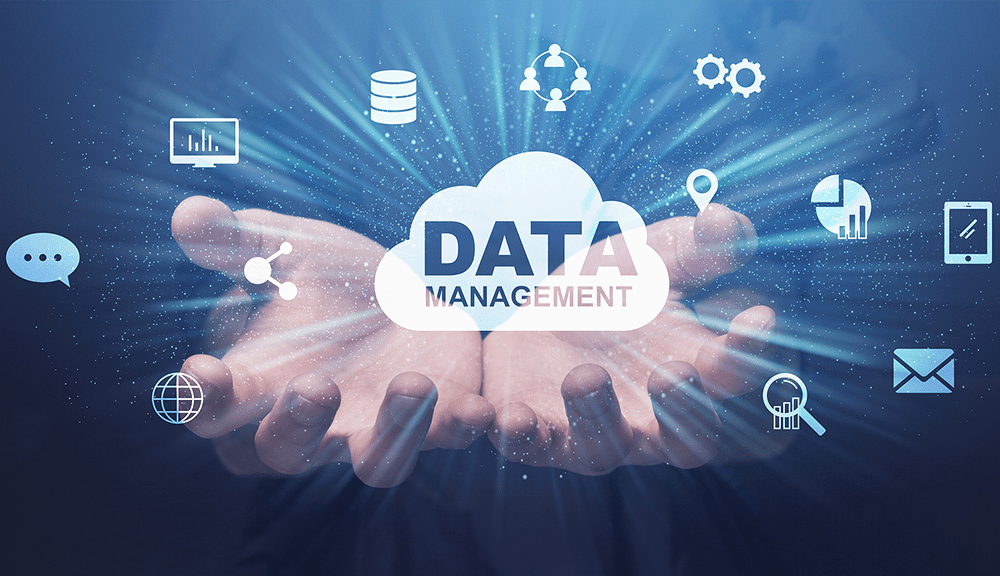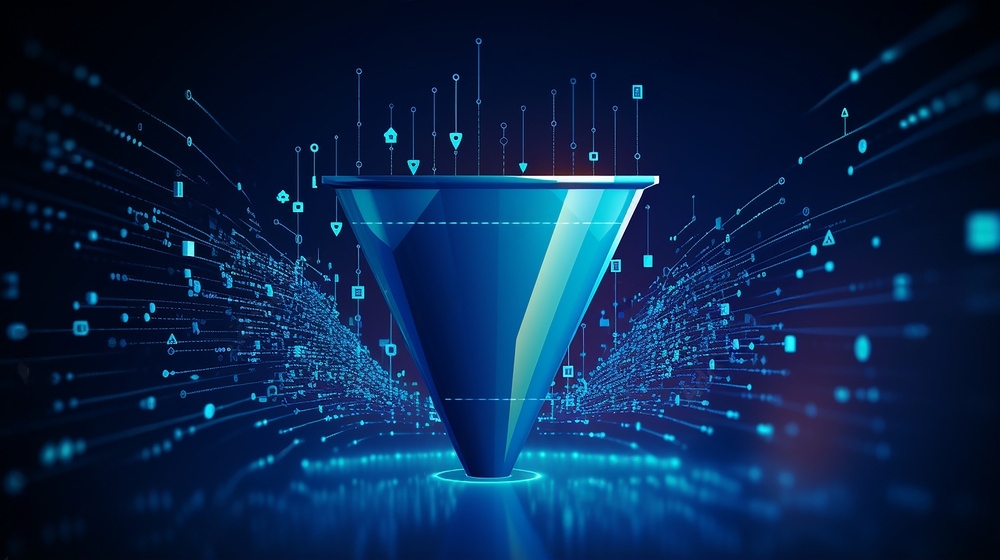In B2B marketing, marketers hold a treasure trove of information – customer interactions, website traffic, campaign performance, and more. But this wealth of data can feel overwhelming, like a mountain of unmined diamonds.
The good news? You don’t need a pickaxe to unlock its potential! Data management and analysis are the tools that transform raw data into sparkling B2B marketing insights.
According to Custom Market Insights (CMI), the master data management market reached approximately USD 5.55 billion in 2021 and is projected to reach about USD 23.8 billion by 2030.
As marketing guru Peter Drucker famously said,
“The best way to predict the future is to create it.”
Data empowers you to do just that. By leveraging data management and analysis, you can avoid assumptions and target the right audience, customize your efforts, and eventually deliver genuine business results.
This guide will be your roadmap to seeing the magic of data in B2B marketing.
We’ll delve into the essential steps of data management, explore powerful analytical techniques, and show you how to translate insights into actionable marketing strategies.
So, get ready to transform your data from a mountain of mystery into a wellspring of marketing success!
Let’s first understand what data management and analysis mean.
What is Data Management and Analysis?
Imagine you’re a detective on a case with a room full of evidence – photos, witness statements, phone records. It’s a wealth of information, but without organization, it’s just a chaotic mess. This is where data management and analysis come into play for B2B marketing.
Data management is like cautiously sorting through the evidence room. You categorize photos and file statements chronologically and ensure everything is accessible. This ensures your data is accurate, organized, and readily available for investigation (analysis).
Data analysis is then like being a skilled detective who knows how to connect the dots. You use various techniques to uncover hidden patterns, connections, and crucial leads within the data.
For B2B marketing, this could mean understanding which marketing channels generate the most qualified leads or identifying customer segments with specific pain points.
The true strength lies in combining both of these qualities. Effective data management ensures your data is reliable and ready for analysis, while powerful analytical tools help you extract valuable insights that solve the marketing mystery – how to reach the right audience with the right message.
Let’s break it down further, using the detective analogy:
Data Management Activities
This is like collecting all the evidence – website analytics, CRM data, customer surveys, and social media interactions. You then meticulously clean and organize it, ensuring accuracy and consistency. Security measures are also crucial, protecting sensitive customer information like witness identities.
Data Analysis Techniques
Once the evidence is organized, you employ various tools and techniques to analyze it. Just like a detective uses fingerprints or ballistics reports, you might use segmentation (grouping customers by industry or behavior) or data visualization (creating charts and graphs to see trends) to uncover crucial insights.
Statistical analysis helps you find deeper connections, similar to how a detective might analyze phone records to identify accomplices. By mastering both data management and analysis, you become a master B2B marketing detective.
You move beyond hunches and gain a clear understanding of your target audience, their needs, and their behavior. This empowers you to create targeted campaigns, personalize your messaging, and ultimately solve the case – driving real results for your business.
What is B2B data analyst?
So, we’ve established that data management and analysis are the secret weapons of successful B2B marketing. But who wields these weapons? Enter the B2B data analyst, the skilled detective who deciphers the clues hidden within your B2B marketing data.
Think back to our detective analogy. The B2B data analyst is the one meticulously collecting evidence (data) from various sources like website traffic, customer surveys, and social media interactions. They then meticulously organize and clean this data, ensuring its accuracy for analysis.
However, their expertise lies in using a variety of analytical tools and techniques to unlock the secrets within. They might delve into customer segmentation, grouping leads based on industry, demographics, or behavior.
Additionally, statistical analysis helps them identify deeper connections and patterns, just like a detective might analyze phone records to uncover accomplices.
The B2B data analyst doesn’t just present raw data; they translate it into actionable insights. They uncover customer needs, identify marketing channels with the highest return on investment (ROI), and measure the effectiveness of campaigns.
This information serves as the foundation for data-driven marketing plans, ensuring that your B2B marketing activities are focused, efficient and eventually result in actual business development.
What is the role of data analytics in B2B marketing?
Imagine steering a ship in thick fog. Without clear visibility, even the most skilled captain would struggle to navigate effectively. This is where data analytics steps in for B2B marketing, acting as the powerful searchlight that cuts through uncertainty and guides your marketing efforts toward success.
The role of data analytics in B2B marketing is multifaceted, but it boils down to one core objective: making informed decisions based on real customer insights, not just assumptions.
Here’s how data analytics helps B2B marketers gain a crucial edge:
Understanding Your Audience
Data analytics empowers you to truly know your target audience. By analyzing website behavior, social media engagement, and customer surveys, you can identify their pain points, interests, and preferred communication channels. This allows you to tailor your messaging and content to resonate with their specific needs, leading to higher engagement and conversion rates.
Optimizing Marketing Campaigns
Data analytics is like a real-time feedback loop for your marketing campaigns. You can track key metrics like website traffic, click-through rates, and lead generation to see what’s working and what’s not. This allows you to fine-tune your campaigns on the fly, allocate resources more effectively, and maximize your return on investment (ROI).
Predicting Customer Behavior
Data analytics is a powerful tool for forecasting future trends. By analyzing past customer behavior and market data, you can identify patterns and predict how potential customers might react to your marketing efforts. This allows you to be more proactive, develop targeted campaigns for specific customer segments, and ultimately close more deals.
Personalization at Scale
B2B buyers expect a personalized experience. Data analytics allows you to segment your audience based on their needs and preferences. This enables you to personalize your marketing messages, content recommendations, and email campaigns, creating a more relevant and engaging experience for each customer.
To put it simply, data analytics is the link that connects B2B marketing tactics to quantifiable outcomes.
By exploiting its potential, you can eliminate guessing and reach the appropriate audience with the right message at the right moment.
This data-driven approach fosters stronger customer relationships, boosts brand loyalty, and ultimately drives sustainable business growth.
What is B2B sales funnel analysis?
We’ve discussed how important data analytics is to B2B marketing, but its influence goes beyond lead generation. Data analytics is also a powerful tool for optimizing your B2B sales funnel, the journey potential customers take from initial awareness to becoming paying customers.
Imagine your sales funnel as a pipeline. Ideally, you want a steady stream of qualified leads entering the top, progressing through the various stages, and ultimately converting into happy customers at the bottom. However, leaks and blockages can occur at any point, hindering your sales efforts.
B2B sales funnel analysis is the process of using data analytics to identify these weaknesses within your sales funnel.
Here’s how it helps:
Identifying Leakage Points
Data analytics reveals where potential customers are dropping off in the sales funnel. Are they not engaging with your website content? Are they abandoning shopping carts during checkout? By pinpointing these leakage points, you can address them strategically. For example, you might improve website navigation or offer abandoned cart recovery campaigns.
Understanding the Customer Journey
B2B sales cycles can be complex, with multiple decision-makers involved. Data analytics helps you map out the customer journey more clearly. You can track how leads interact with your marketing materials, identify the content they value most, and understand their decision-making process. This knowledge allows you to tailor your sales approach and nurture leads more effectively.
Optimizing Lead Scoring
Data analytics empowers you to develop a lead scoring system. By assigning points based on demographics, website behavior, and engagement with marketing materials, you can prioritize leads with the highest conversion potential. This ensures your sales team focuses their efforts on the most promising prospects.
Measuring Sales Performance
Gone are the days of relying solely on intuition to measure sales success. Data analytics provides concrete metrics to track your sales performance. You can analyze conversion rates at each stage of the funnel, identify top-performing salespeople, and measure the effectiveness of your sales strategies.
By leveraging B2B sales funnel analysis, you gain a data-driven perspective on the entire sales process. This allows you to optimize each stage, identify areas for improvement, and ultimately turn more leads into loyal customers.
Data analytics is the key to building a high-performing B2B sales funnel that consistently delivers results.
How could a B2B company apply big data analytics?
So far, we’ve explored how data analysis empowers B2B marketing. But what if you have a vast ocean of data, not just a manageable stream? That’s where big data analytics comes in, offering B2B companies the power to analyze massive datasets and uncover even deeper customer insights.
Think of it like this: Traditional data analytics is like studying a specific map of your city. You gain valuable knowledge about the area, but there’s a whole world beyond it. Big data analytics is like having access to a global map, allowing you to see connections and patterns across vast geographical regions.
Here’s how B2B companies can leverage big data analytics:
1# Uncovering Hidden Relationships
Big data allows you to analyze massive datasets from various sources, including social media sentiment, customer reviews, and industry reports. This enables you to identify previously unseen connections and trends that might influence customer behavior. For example, you might discover a correlation between a specific industry event and increased demand for your product.
2# Predictive Analytics
By analyzing historical data and real-time trends, big data allows you to predict future customer needs and behavior with greater accuracy. This enables you to be more proactive in your marketing efforts. You can anticipate buying cycles, personalize content based on predicted needs, and launch targeted campaigns before your competitors.
3# Hyper-Personalization
Big data empowers you to personalize your B2B marketing on a whole new level. By analyzing customer behavior and preferences in granular detail, you can tailor content, product recommendations, and even pricing strategies to each individual customer segment. This creates a more relevant and engaging experience for your audience, fostering stronger brand loyalty.
4# Optimizing Pricing Strategies
Big data allows you to analyze competitor pricing, customer buying habits, and market trends. This empowers you to develop dynamic pricing models that are competitive yet maximize your profit margins.
While big data analytics offers immense potential, it requires robust infrastructure and skilled data scientists to manage and interpret the vast amount of information. However, for B2B companies willing to invest in these capabilities, the rewards are substantial. Big data analytics empowers you to make smarter marketing decisions, optimize the customer journey, and ultimately achieve a significant competitive advantage.
How do you use data analysis in B2B marketing?
So, we’ve unpacked the power of data analytics in B2B marketing, from understanding your audience to optimizing sales funnels. But how do you actually translate this knowledge into action? Here’s a look at some practical ways B2B marketers can leverage data analysis:
1# Content Marketing with a Data-Driven Edge
Stop guessing what content resonates with your audience! Analyze website traffic data to see which blog posts attract the most attention. Use social media listening tools to understand industry trends and identify hot topics your audience is discussing. By creating content that directly addresses your audience’s needs and interests, you’ll attract higher-quality leads and boost engagement.
2# Targeted Advertising that Converts
Gone are the days of scattershot advertising campaigns. Use website visitor data to segment your audience based on demographics, interests, and online behavior. Then, leverage advertising platforms to deliver targeted ads that resonate with each segment. This laser-focused approach increases click-through rates and conversion rates, maximizing your advertising spend.
3# Personalization Beyond Names
Data analysis allows you to personalize your marketing beyond just a simple salutation. Analyze customer purchase history and website behavior to recommend relevant products or services. Craft email campaigns with dynamic content that adapts based on individual customer preferences. This one-on-one approach fosters stronger customer relationships and increases the likelihood of repeat business.
4# Measuring Success Beyond Likes and Shares
Social media engagement is great, but it doesn’t necessarily translate to sales. Use data analysis to track website traffic generated from social media campaigns. Measure lead generation metrics, like form submissions or contact requests, to identify which social media platforms deliver the most qualified leads. This data-driven approach helps you optimize your social media strategy for maximum impact.
5# A/B Testing for Continuous Improvement
Data analysis is all about experimentation and refinement. Use A/B testing to compare different versions of landing pages, email subject lines, or call-to-action buttons. Analyze which version performs better and use those insights to continuously improve your marketing materials.
This data-driven approach ensures you’re always delivering the best possible experience for your audience. By incorporating these data analysis techniques, B2B marketers can move beyond intuition and guesswork.
Data can be utilized to develop targeted marketing strategies, personalize customer experiences, and ultimately yield measurable business outcomes. Data analysis is the key to unlocking the full potential of B2B marketing and achieving sustainable success.
How can B2B marketing companies use data to improve customer data?
We’ve established data analysis as the cornerstone of successful B2B marketing. But what about the data itself? High-quality customer data is the fuel that powers your marketing engine.
Here’s how B2B marketing companies can leverage data analysis to refine and improve their customer data:
1# Identifying Data Gaps and Inconsistencies
Data is only valuable if it’s accurate and complete. Data analysis helps you identify missing information or inconsistencies within your customer data. For example, you might discover duplicate entries for the same lead, outdated contact details, or incomplete customer profiles.
2# Data Cleansing and Enrichment
Once you’ve identified data gaps and inconsistencies, you can take steps to cleanse and enrich your customer data. This might involve removing duplicate entries, correcting outdated information, and filling in missing details through website behavior analysis or social media insights.
3# Segmentation for Targeted Communication
High-quality customer data allows for more effective segmentation. By analyzing various data points like demographics, industry, and purchase history, you can group customers with similar characteristics and needs. This enables you to deliver targeted marketing messages and content that resonate with each segment, fostering deeper engagement.
4# Building Customer Personas
Data analysis empowers you to create detailed customer personas and fictional representations of your ideal customers. By analyzing data from various sources, you can understand your target audience’s demographics, pain points, buying behavior, and online preferences. This allows you to tailor your marketing efforts to directly address their specific needs and challenges.
5# Customer Journey Mapping
Data analysis helps you map out the customer journey – all the touchpoints a customer has with your brand. By analyzing website traffic data, customer interactions, and social media engagement, you can identify potential roadblocks within the journey. This allows you to optimize communication at each stage, ensuring a smooth and seamless customer experience.
By using data analysis to improve customer data quality, B2B marketing companies gain a deeper understanding of their audience. The data-driven approach allows for personalized communication, targeted marketing, and stronger customer relationships, fostering loyalty and driving sustainable business growth.
How is data used in an effective B2B sales and marketing process?
We’ve looked at how data analysis can transform B2B marketing and customer data management. However, the magic happens when these two forces work together, resulting in a data-driven synergy that propels both sales and marketing success.
Here’s how data fuels an effective B2B sales and marketing process:
1# Targeting the Right Audience
Marketing leverages data analytics to identify ideal customer profiles. Demographics, industry trends, and online behavior patterns paint a clear picture of your target audience. This empowers sales teams to focus their efforts on qualified leads with higher conversion potential.
2# Personalized Lead Nurturing
Data analysis allows marketing to personalize lead nurturing campaigns. By understanding customer preferences and pain points, marketing can deliver targeted content and email sequences that resonate with each lead. This warms them up for the sales team, increasing the likelihood of a successful conversion.
3# Qualifying Leads with Data Insights
Marketing doesn’t just generate leads; it qualifies them too. Website behavior data and lead scoring models help identify leads with a high buying intent. This ensures the sales team focuses their energy on the most promising prospects, maximizing their time and resources.
4# Sales Enablement with Data-Driven Insights
Data empowers the sales team with valuable customer insights. Sales representatives can tailor their pitches based on specific customer needs, industry challenges, and past interactions. This personalized approach increases engagement and fosters trust with potential buyers.
5# Measuring Success and ROI
Data analysis allows both marketing and sales to measure campaign effectiveness. Trackable metrics like website traffic, conversion rates, and deal-closing times provide valuable insights. This data-driven approach helps optimize strategies, identify areas for improvement, and demonstrate the return on investment (ROI) for both sales and marketing efforts.
Ultimately, data is the bridge between B2B sales and marketing. By targeting the correct audience and tailoring interactions, data analytics can help B2B businesses increase revenue, establish client loyalty, and maintain a competitive advantage.
Conclusion
Data analysis is the secret weapon of B2B marketing success. This guide reveals its potential, from understanding your audience to optimizing sales. By wielding data management, analytics, and big data, you can refine customer data, personalize marketing, and conquer the funnel.
If you want to improve your business’s data management, we are here to help. To learn more about our data management services, contact us now.
FAQs
What is the B2B customer data model?
The B2B customer data model acts as a blueprint for organizing and managing all your B2B customer data. It considers the unique aspects of B2B interactions, like focusing on companies instead of individual consumers, and ensures data is readily available for marketing, sales, and other teams.
Which four categories of B2B clients are there?
- New Customers: These are businesses you haven’t converted yet. Understanding their needs and challenges is crucial for attracting them.
- Existing Customers: These are businesses that have already bought from you. Retaining them through excellent service and targeted marketing is key.
- Loyal Customers: These are your most valuable customers who consistently choose you. Understanding their preferences helps maintain loyalty.
- At-Risk Customers: These are existing customers who might be considering switching providers. Identifying them early allows you to take corrective action.
What are the 4 pillars of B2B marketing?
- Content Marketing: Creating valuable content (blogs, articles, white papers) attracts and educates your target audience.
- Search Engine Optimization (SEO): Optimizing your website and content for search engines ensures potential customers can easily find you online.
- Social Media Marketing: Engaging with your audience on social media platforms builds brand awareness and fosters relationships.
- Email Marketing: Sending targeted email campaigns keeps your audience informed, promotes new offerings, and nurtures leads.
What are the 4 Cs and 4 Ps of marketing?
The 4 Ps (Product, Price, Place, and Promotion) are the traditional marketing mix that focuses on the marketer’s perspective. Let’s break them down:
- Product: This refers to the good or service you’re offering, including its features, benefits, and quality.
- Price: This is the cost a customer pays for your product, considering factors like production costs, competition, and perceived value.
- Place: This refers to where your product is made available to customers, including distribution channels and sales outlets.
- Promotion: This encompasses all your marketing and advertising efforts to create awareness, interest, and ultimately sales.
The 4 Cs (Customer, Cost, Convenience, and Communication) are a more customer-centric approach to marketing. Here’s how they differ:
- Customer: This replaces “Product,” focusing on understanding customer needs and wants to tailor offerings accordingly.
- Cost: While similar to “Price,” it considers the total cost of ownership for the customer, including purchase price, maintenance, and value over time.
- Convenience: This emphasizes making it easy for customers to purchase and use your product, focusing on accessibility and a smooth buying experience.
- Communication: This goes beyond traditional promotion, highlighting a two-way dialogue with your audience. It’s about building relationships and understanding customer feedback.
What is the main role of data analysis?
The main role of data analysis is to extract hidden insights and meaning from the data. It’s like sifting through a pile of rocks to find valuable gems. Data analysis utilizes various techniques to comprehend patterns, trends, and relationships within data, enabling informed decision-making, problem-solving, and ultimately achieving goals.






